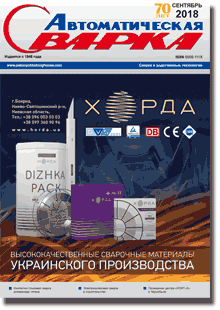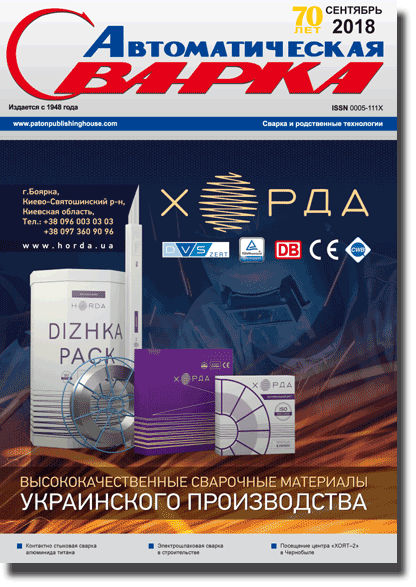| 2018 №09 (08) |
DOI of Article 10.15407/as2018.09.01 |
2018 №09 (02) |

Avtomaticheskaya Svarka (Automatic Welding), #9, 2018, pp. 3-8
Resistance butt welding of titanium aluminide γ-TiAl with VT5 alloy
S.I.Kuchuk-Yatsenko, I.V. Zyakhor, A.O. Nakonechny, M.S. Zavertanny, L.M. Kapitanchuk
E.O. Paton Electric Welding Institute of the NAS of Ukraine. 11, Kazimir Malevich str., 03150, Kiev, Ukraine. E-mail: office@paton.kiev.ua
In the work, the peculiarities of formation of dissimilar joints of Ti-46A1-2Cr-2Nb alloy on the base of titanium aluminide g-TiAI with titanium alloy VТ5 in resistance butt welding, in particular, using interlayers in the form of nanolayer foils were studied. In resistance butt welding without the use of nanolayer foils it was failed to provide the defect-free joints: in the butts the presence of areas of cast metal and cracks was detected. It was found that the use of Ti/Cu and Cu-Ti/Ni-C systems as an interlayer of nanolayer foils of an eutectic type significantly influences the activation processes of the surfaces to be welded and the formation of joints in resistance butt welding. The presence of nanolayer foils in the contact zone facilitates the formation of a thin layer of the liquid phase at the initial stage of heating process, localization of heat evolution process, activation of surfaces of both alloys with the duration of heating stage of 50...60% of such at the direct resistance welding of alloys g-TiAI and VТ5. The two-stage pressure cyclogram in RBW provides crystallization of eutectics in the process of deformation of billets and the formation of defect-free joints at the values of heating temperature, which are lower than the liquidus temperature in the system Ti-AI. According to the data of scanning electron microscopy and the ESD-analysis, , the absence of the areas of cast metal and the remnants of nanosheet foils in the zone of joints was established, which testifies the solid-phase nature of the formation of joints and the complete displacement of nanolayer foils beyond the cross-section of the billets. 12 Ref., 8 Fig.
Keywords: titanium aluminide, VT5 alloy, resistance butt welding, nanolayer foil, solid-phase joint
Received: 17.07.2018
Published: 20.09.2018
References 1. Chesnutt, J., Hall, J., Lipsitt, H. (1995) Titanium intermetallics — present and future. In: of 8th Wolrd Conf. of Titanium (UK, Birmingham, 22–26 October, 1995). The Institute of Materials, 70–79.
2. Hurta, S., Clemens, H., Frommeyer, G. et al. Valves of intermetallic γ-TiAl-based alloys: Processing and Properties. Ibid., 97–104.
3. Iliin, A.A., Kolachev, B.A., Polkin, I.S. (2009) Titanium alloys. Composition, structure, properties: Refer. Book. Moscow, VILS-MATI [in Russian].
4. Kablov, E.N., Lukin, V.I. (2008) Intermetallics based on titanium and nickel for advanced engineering products. The Paton Welding J., 11, 65–70.
5. Grigorenko, S.G., Grigorenko, G.M., Zadorozhnyuk, O.M. (2017) Intermetallics of titanium. Peculiar features, properties, application (Review). Elektrometall., 3, 51–58 [in Russian]. https://doi.org/10.15407/sem2017.03.08
6. Jian Cao, Junlei Qi, Xiaoguo Song, Licai Feng (2014) Welding and joining of titanium aluminides. Materials, 7(7), 4930–4962. https://doi.org/10.3390/ma7074930
7. Yushtin, A.N., Zamkov, V.N., Sabokar, V.K. et al. (2001) Pressure welding of intermetallic alloy γ-TiAl. The Paton Welding J., 1, 33–37.
8. Sabokar, V.K., Akhonin, S.V., Petrichenko, I.K. et al. (2009) Pressure welding of titanium aluminide to other titanium alloys. Ibid., 12, 10–12.
9. Gorban, V.F., Kharchenko, G.K., Falchenko, Yu.V. et al. (2009) Investigation of joints of titanium aluminide with titanium alloy VT8 produced by diffusion welding. Ibid., 12, 7–9.
10. Kuchuk-Yatsenko, V.S., Shvets, V.I., Sakhatsky, A.G. et al. (2009) Features of resistance welding of titanium aluminides using nanolayered aluminium-titanium foils. Ibid., 3, 11–14.
11. Kuchuk-Yatsenko, S.I., Zyakhor, I.V., Chernobaj, S.V. et al. (2015) Structure of γ-TiAl joints in resistance butt welding with application of interlayers. Ibid., 9, 5–12. https://doi.org/10.15407/tpwj2015.09.01
12. Barabash, O.M., Koval, Yu.N. (1986) Cryslalline structure of metals and alloys: Refer. Kiev, Naukova Dumka [in Russian]
The cost of subscription/purchase order journals or individual articles
| Journal/Currency | Annual Set | 1 issue printed |
1 issue |
one article |
| TPWJ/USD | 384 $ | 32 $ | 26 $ | 13 $ |
| TPWJ/EUR | 348 € | 29 € | 24 € | 12 € |
| TPWJ/UAH | 7200 UAH | 600 UAH | 600 UAH | 280 UAH |
| AS/UAH | 1800 UAH | 300 UAH | 300 UAH | 150 UAH |
| AS/USD | 192 $ | 32 $ | 26 $ | 13 $ |
| AS/EUR | 180 € | 30 € | 25 € | 12 € |
| SEM/UAH | 1200 UAH | 300 UAH | 300 UAH | 150 UAH |
| SEM/USD | 128 $ | 32 $ | 26 $ | 13 $ |
| SEM/EUR | 120 € | 30 € | 25 € | 12 € |
| TDNK/UAH | 1200 UAH | 300 UAH | 300 UAH | 150 UAH |
| TDNK/USD | 128 $ | 32 $ | 26 $ | 13 $ |
| TDNK/EUR | 120 € | 30 € | 25 € | 15 € |
AS = «Automatic Welding» - 6 issues per year;
TPWJ = «PATON WELDING JOURNAL» - 12 issues per year;
SEM = «Electrometallurgy Today» - 4 issues per year;
TDNK = «Technical Diagnostics and Non-Destructive Testing» - 4 issues per year.





